
Page 8: of Marine Technology Magazine (November 2011)
FreshWater Monitoring and Sensors
Read this page in Pdf, Flash or Html5 edition of November 2011 Marine Technology Magazine
news A group of Arctic researchers has employed the latest monitoring tech- nology to investigate the effects of cli- mate change, by measuring tempera- ture and salinity in the water column beneath surface ice. The results of the investigation, which used YSI?s new Castaway-CTD, could cast new light on our understanding of the ways inwhich shifting ocean currents impact upon the climate in northern Europe. The Catlin Arctic Survey is a unique collaboration between scientists and explorers, and the Castaway enabled the researchers to work very quickly in extremely hostile conditions because the device is small, portable and can be operated in the field with-out the aid of a computer. Previous research looked at ice thickness and ocean acidification, butthe latest Catlin Survey work has studied freshwater currents beneath the ice surface to help understand their effect on bottom-up ice melting,which is disrupting global ocean cir- culation.It is well established that the Arctic environment has a significant effect upon the global climate. For many years, climate scientists have raised concerns over future shifts in global weather systems and highlighted the role that the Arctic plays in such sys- tems. Changes in the Arctic heavily contribute to the Thermohaline Circulation; a giant aquatic conveyor connecting the planet's oceans, dis-tributing heat, oxygen and nutrients. Changes to the Thermohaline Circulation combined with vast atmospheric, positive feedback loops (that produce large quantities of methane from the melting per- mafrost) that occur within the Arctic, can have drastic repercussions on the global climate. In 2011 the Catlin Arctic Survey was commissioned by The Catlin Group to assess the temporary ice base on the Prince Gustav Adolf Sea, on the northern most fringe of Canada?s Arctic archipelago, around 800 miles from the North Pole. Organic Matter A key measurement parameter for the team was Colored Dissolved Organic Matter (CDOM), because high levels can result in 40% higher light absorption. In the Arctic, much of the CDOM is derived from three of Northern Russia?s vast river mouths. Commenting on the signifi-cance of CDOM, Dr Victoria Hill, a British-born Oceanographer, said: ?Locally CDOM should act toincrease thermal stratification, trap- ping heat near the surface. The water becomes more stable and there is reduced mixing. However, if surface ice melts, it creates an upper layer of fresh, cold water which does not mix. In the long run, the surface water becomes warmer and no longer sinksto form the deep and colder waterthat draws the Gulf Stream to Northern Europe.? The researchers anticipated that the Arctic Ocean would be highly trans- parent, because the rivers contribut- ing CDOM were frozen. However, the team determined that this was notthe case. In fact, Dr. Hill revealed: ?In the Chukchi, between 70 and 80% of solar radiation was being absorbed by CDOM." In another data set, retrieved by Adrian McCullum, from the Scott Polar Research institute, concerning results were obtained from a sample of the water column; at a depth below 200m, the water was 1 Deg C colder than expected. This sig- nificant change in normally stable,deep water, suggests that the surface melt water was sinking, drivingwarmer water into contact with thesurface ice. This sparked further interest into the variation of tempera- ture in the Arctic Ocean. Arctic Ocean Profiling Highly specialized equipment is necessary for profiling very deep water. However, YSI's Castaway CTD has been developed to provide a simple and accurate method for therapid determination of conductivity, temperature and depth down to 100m. Incorporating GPS, sensors, data logging and a display into one8MTRNovember/December 2011New Monitoring Tech helps Reveal Secret Arctic MTR#9 (1-17):MTR Layouts 11/29/2011 10:06 AM Page 8

 7
7

 9
9
